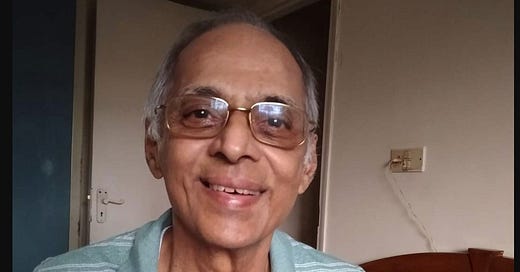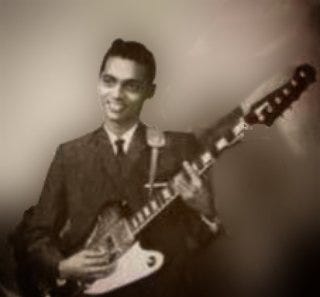Dilip Naik - the legendary Bollywood guitarist
Spoiler Alert: It is not a story with a happy ending
Consider the following tune from Kismat (1968). [Pay attention to the guitar solo.]
Pure Dilip Naik.
Lakhon hay yahan dilwale
I have deliberately extracted the audio so that you do not get sidetracked by the visuals. [Some love but others loathe Biswajit. He gave lips to a large number of Hindi songs like this. If you click there, you will hear an 80 year old Biswajit is actually singing the song. He sang a goodly number of Bengali (Puja) songs like this one.]
Evening in Paris (1967) title song brought another jingle from Dilip Naik.
I have taken out the visuals. [There is something seriously wrong with the visuals as well. The background where Shammi Kapoor sings is definitely not Paris but Hamburg, Germany - specifically in the Red Light District of St. Pauli - der Kiez.]
Perhaps the more controversial song (because Sharmila Tagore appeared in a swimsuit) was Aasman Se. Fifty seconds of Dilip Naik blazes at the start.
Dilip Naik blasts into the intro of “Aja aja main hoon pyar tera” from Teesri Manzil (1966).
The most iconic Dilip Naik comes from this song: Jan pehchan ho [Gumnaam, 1965].
It has been used in a Heineken commercial, opening credits in the Ghost World (2001), among others. If you listen to the first three numbers above and compare them with the last one, you will notice one clear difference in that guitar solo: The last one is being played one octave down - not the usual Dilip Naik style. This was done at the direction of Jaikishan - who conjured up the magical tune. Once again, I have extracted the tune so that you do not get caught up with the visuals and concentrate on Dilip Naik’s guitar solo. [The imagery is unique: Laxmi Chhaya’s high voltage moves are matched by Herman Benjamin - the dance master who fronts the singing. The story of Benjamin is the subject of another writeup.]
Mr. Naik was always into music. He played the harmonica as a teenager. However, in 1956 when he heard San Antonio Rose by Les Paul (and Mary Ford), he was smitten by the sound of guitar. He got himself a German acoustic guitar from Dhobi Talao for 70 rupees - a princely sum then. He went on a six month tour with his friends playing across Kashmir in 1960. He got noticed by the well-known music arranger Sebastian D’Souza who was a regular at Shankar Jaikishan’s Big Band.
Mr. Naik got to play his guitar in Asli Naqli (1962) but among three rhythm guitar players.
Finally he got a chance to play solo in Beti Bete (1964). The only catch was - he had to play an electric guitar and he did not have one. He had to borrow one. [The movie starred B. Saroja Devi - the famed South Indian actress. Acclaimed journalist Bishwanath Ghosh once did a wild interview with her. During the entire time of the interview, she was lying in her bed in her nightgown.]
He played with many music directors during the 1963-1975 period. He ran into a lean period. So, he decided to try his luck in New York City jazz bands. In two years, he played a lot but not much income. He collaborated with Vasant Rai in New York. His contribution in Spring Flowers is a testament to his mastery of (acoustic) guitar for (North) Indian Classical music.
Dejected and broke, he went back to Bombay. By then, he found no jobs in Bombay either. He tried his luck again in the US - this time in Houston in 1982. He had to quit again as he could not make a living out of playing the guitar he so loved to play. Eighty-odd years old Dilip Naik lives in obscurity in Navi Mumbai.
[A lot of what I wrote here is based on a chat I had with Mr. Naik in Leicester in 2003. He was the judge in a competition of local guitar players who were playing his tunes from the Hindi movies in the 1960s.]





“Full many a gem of purest ray serene
The dark unfathomed depths of ocean bear.
Full many a flower is born to blush unseen,
And waste its fragrance on the desert air”
These memorable lines come to mind on reading this sad tale of Mr Naik’s (mis)adventures.
Maybe we can track him down, sit him down, and get him to reminisce, as you did in the past?